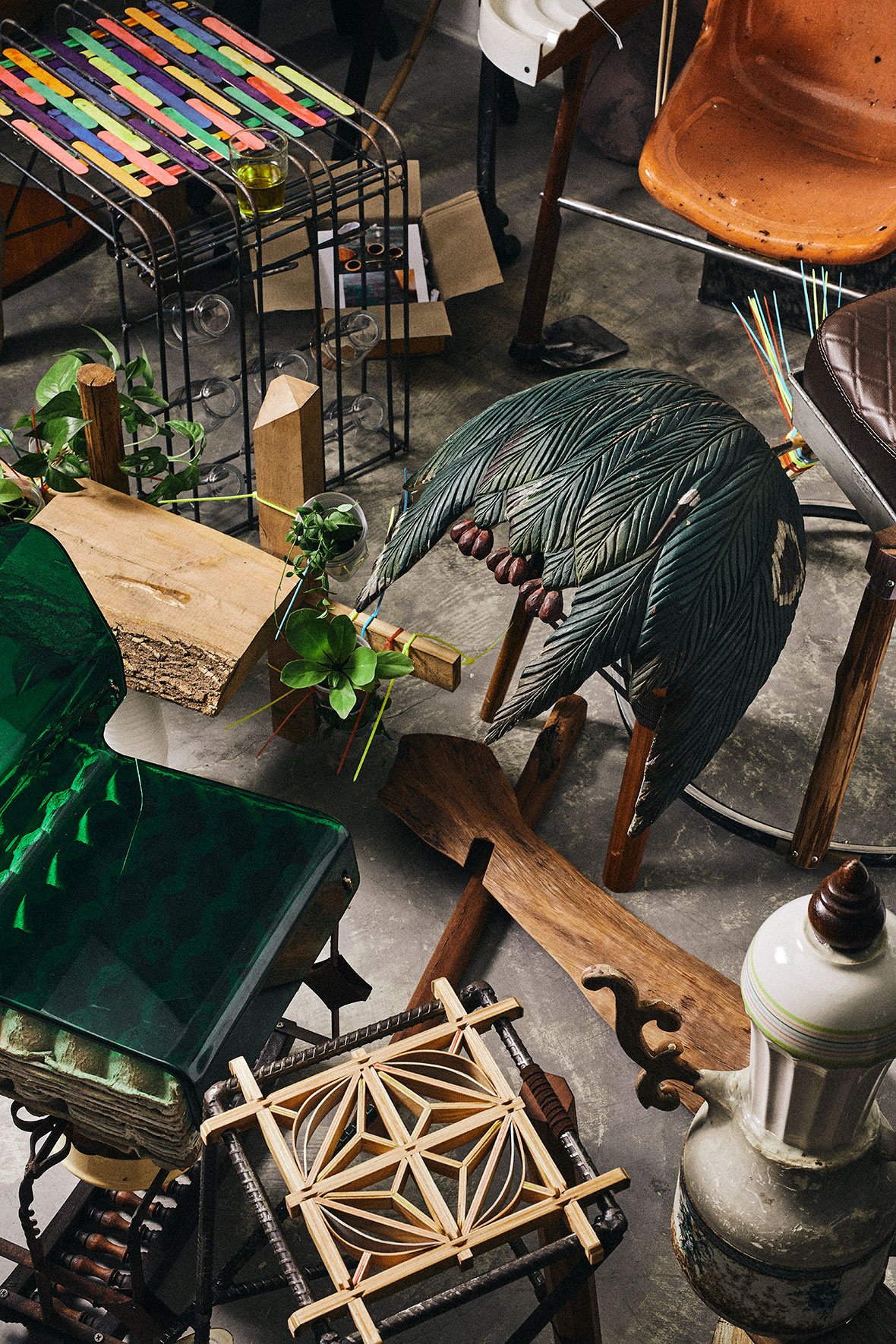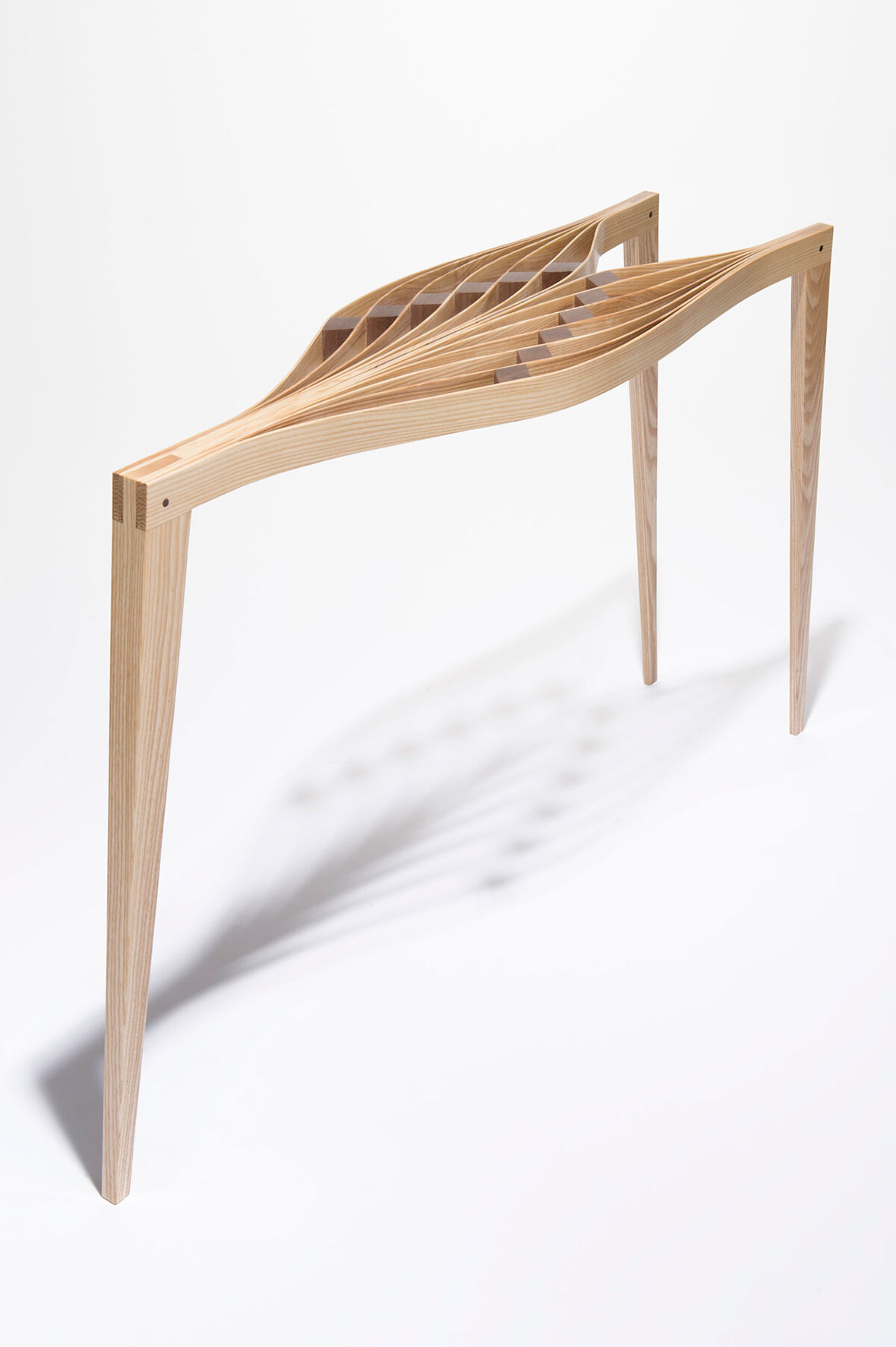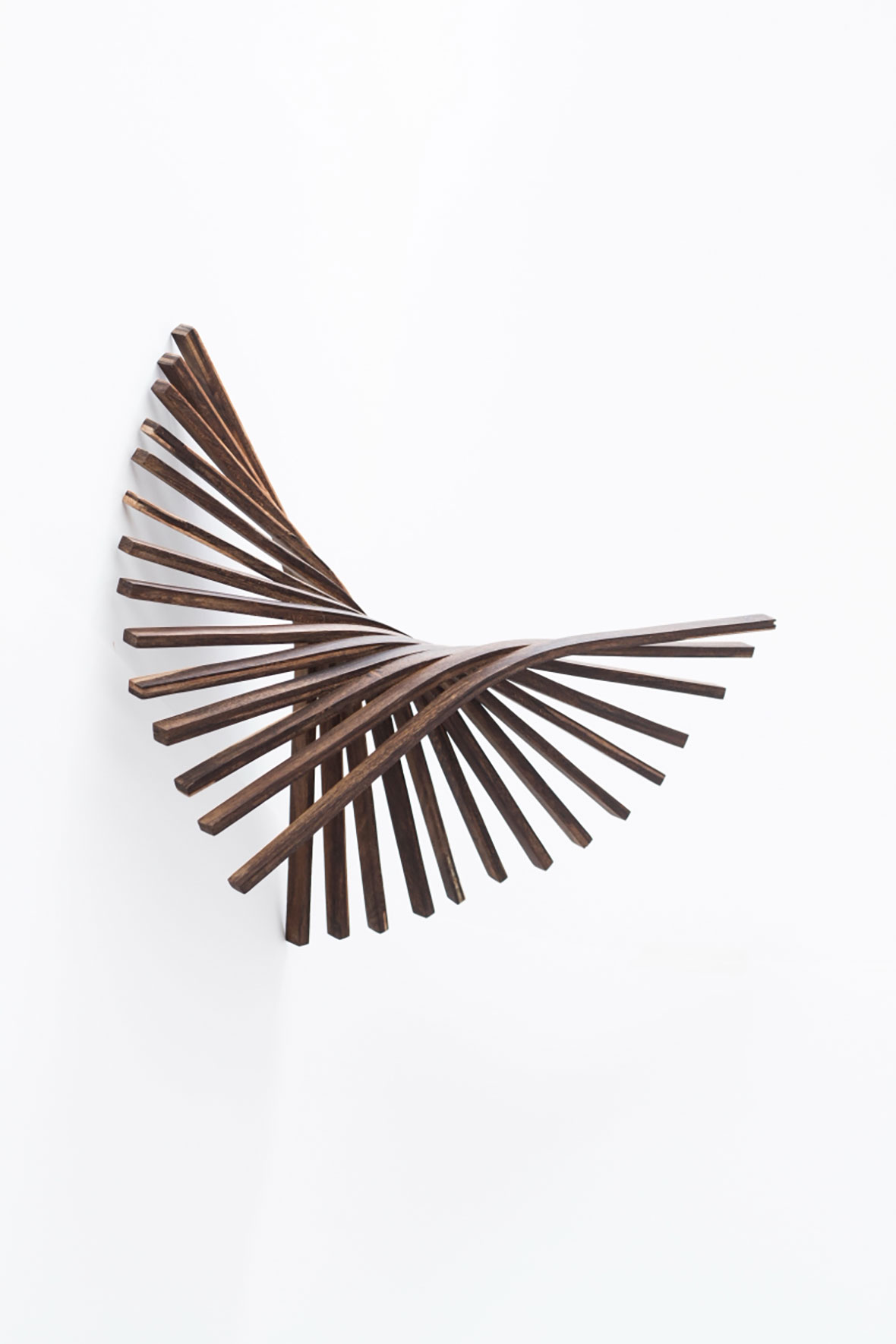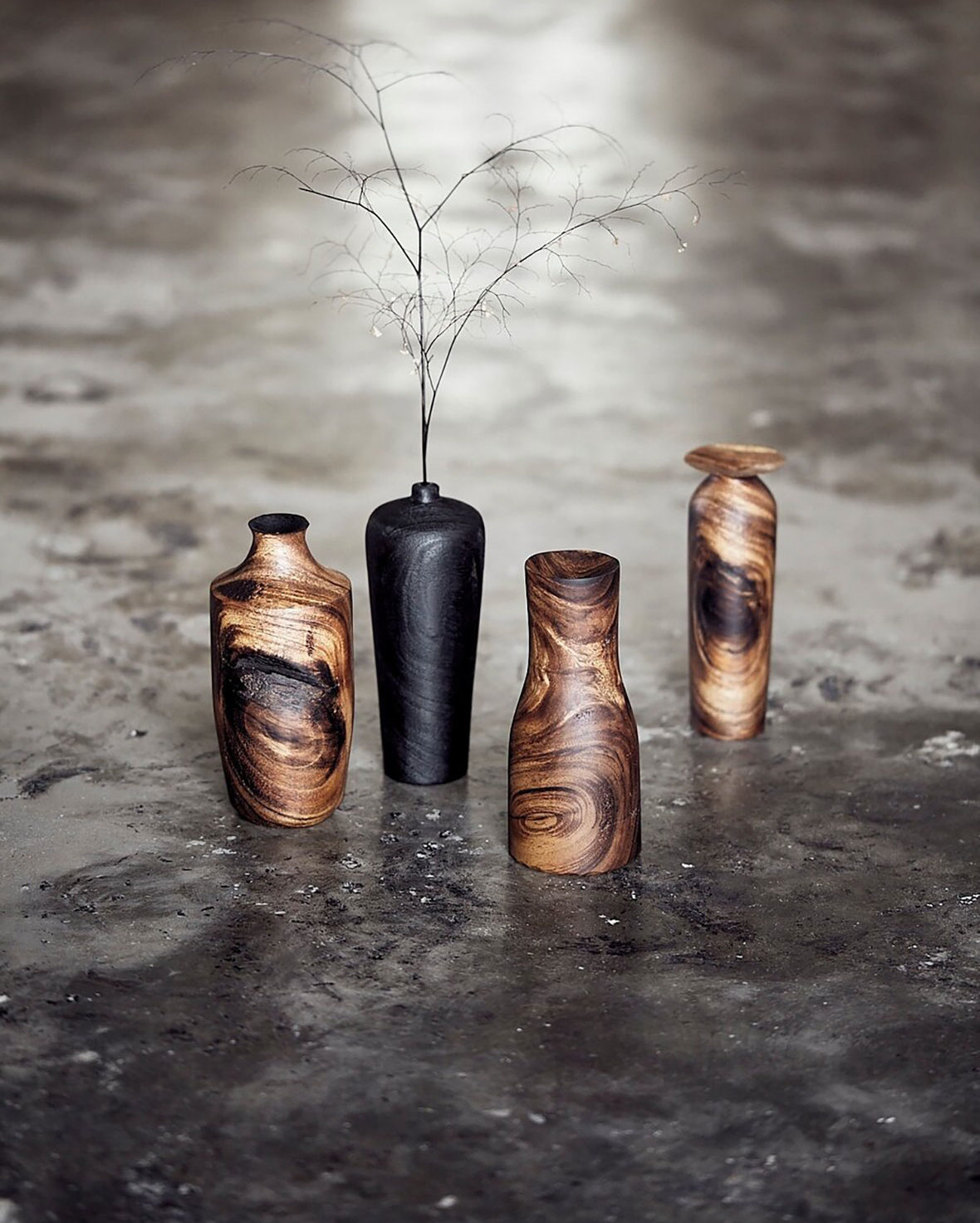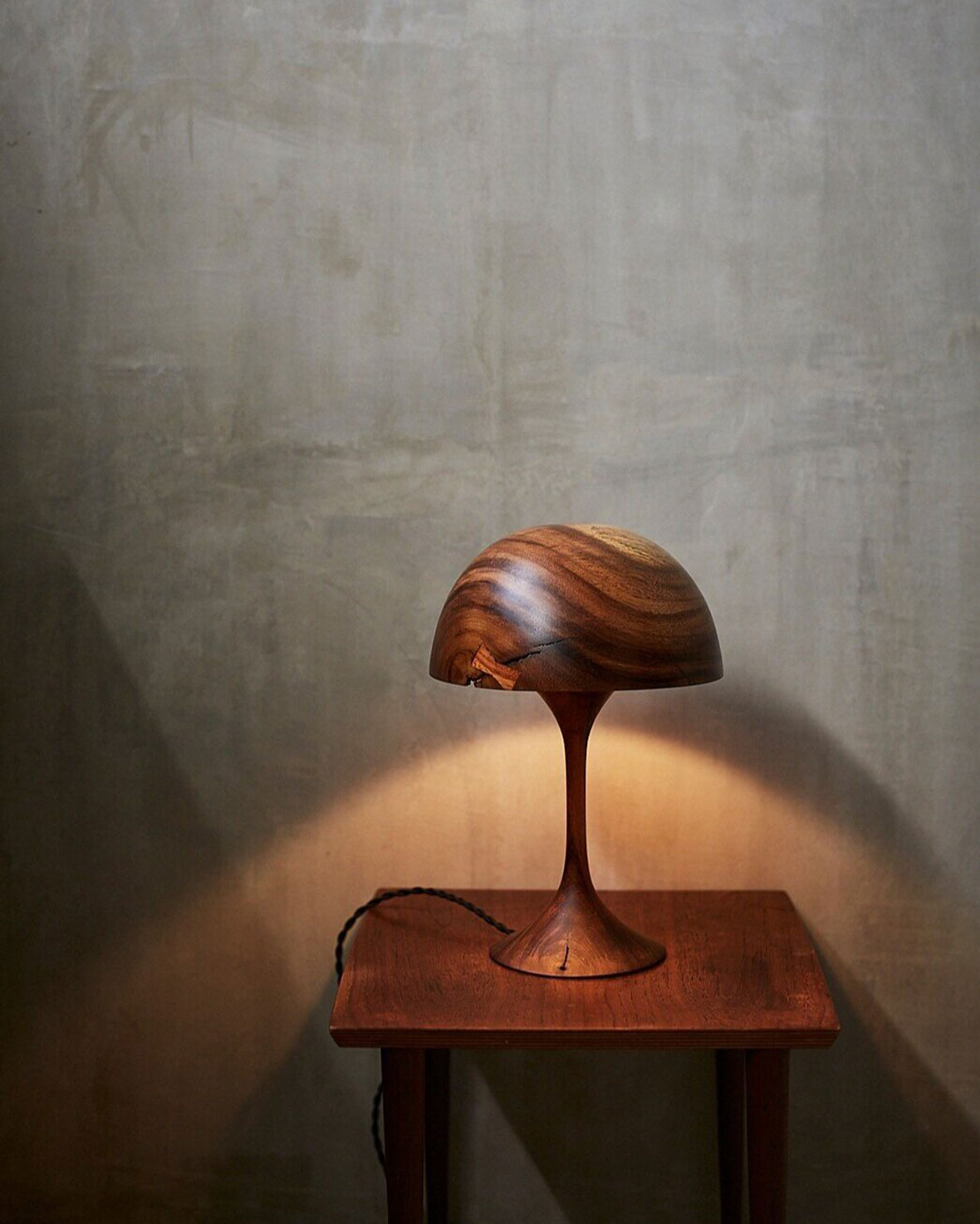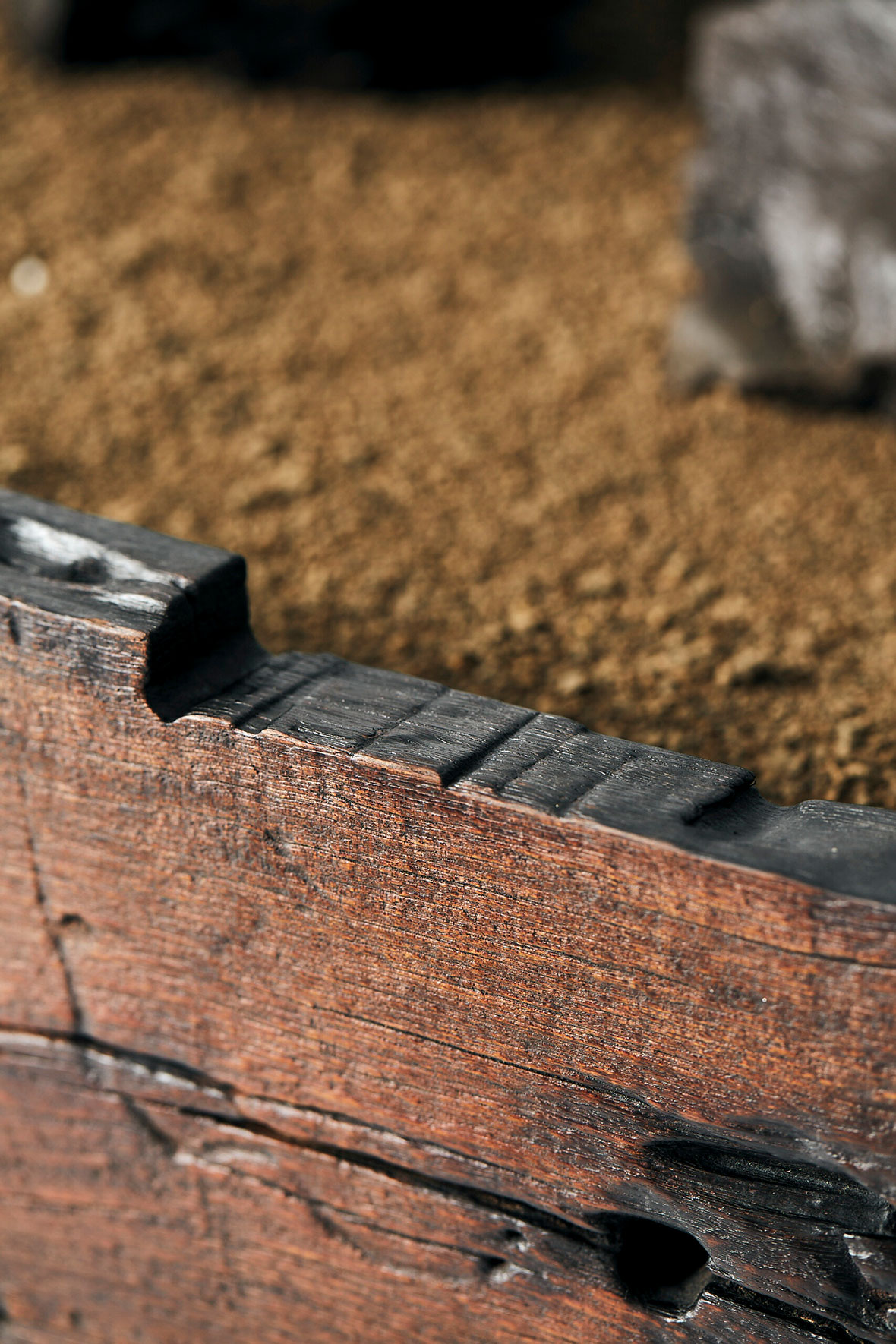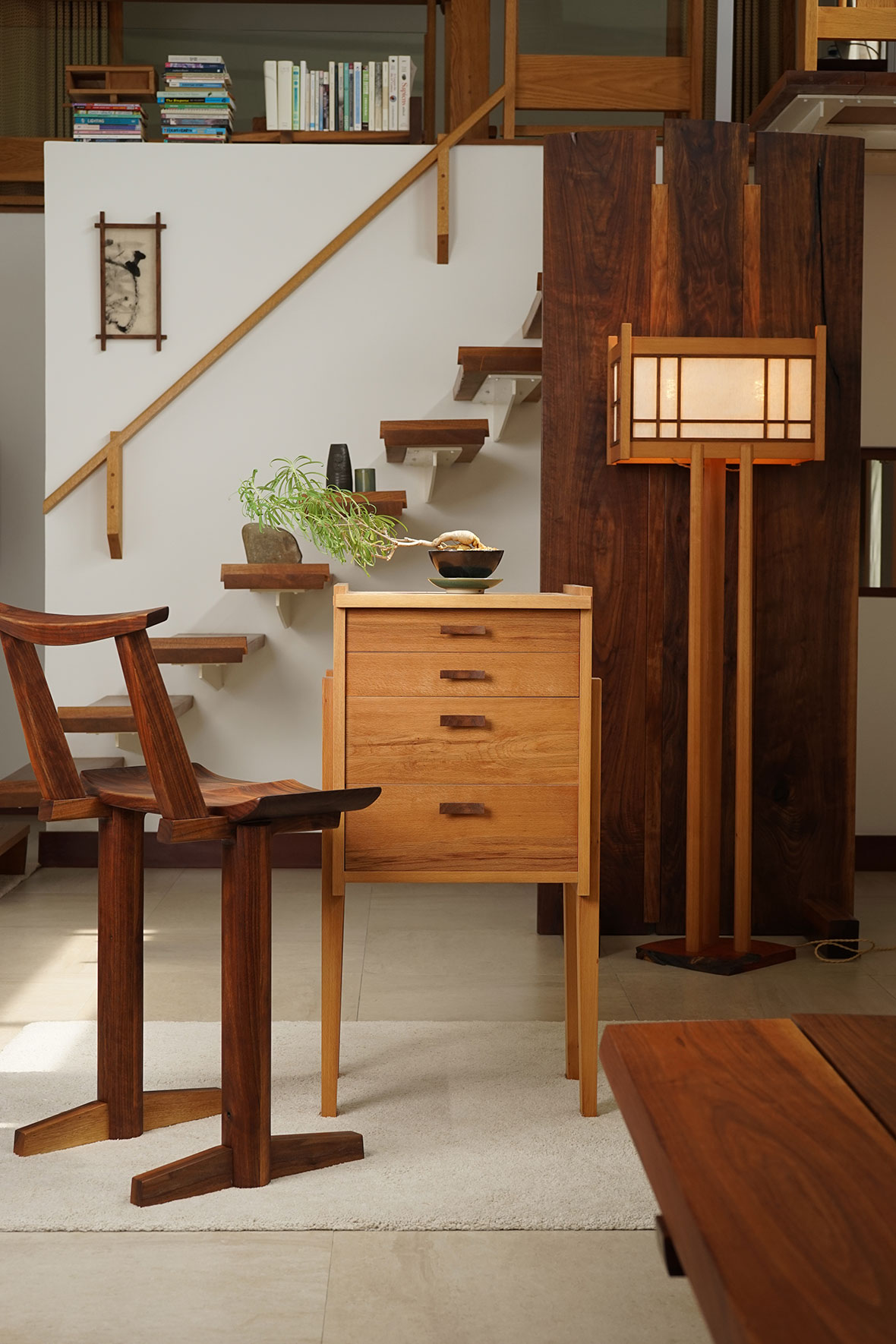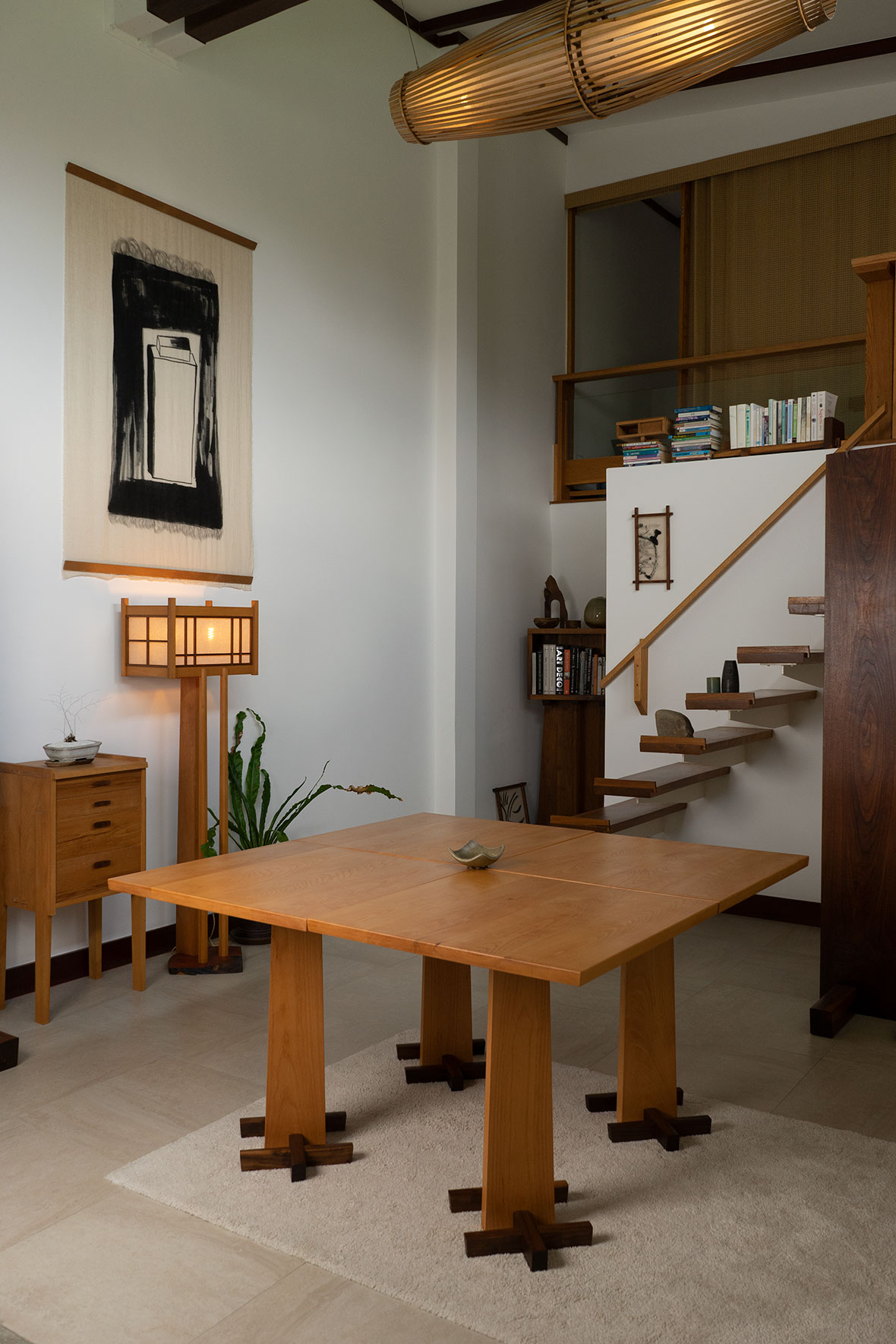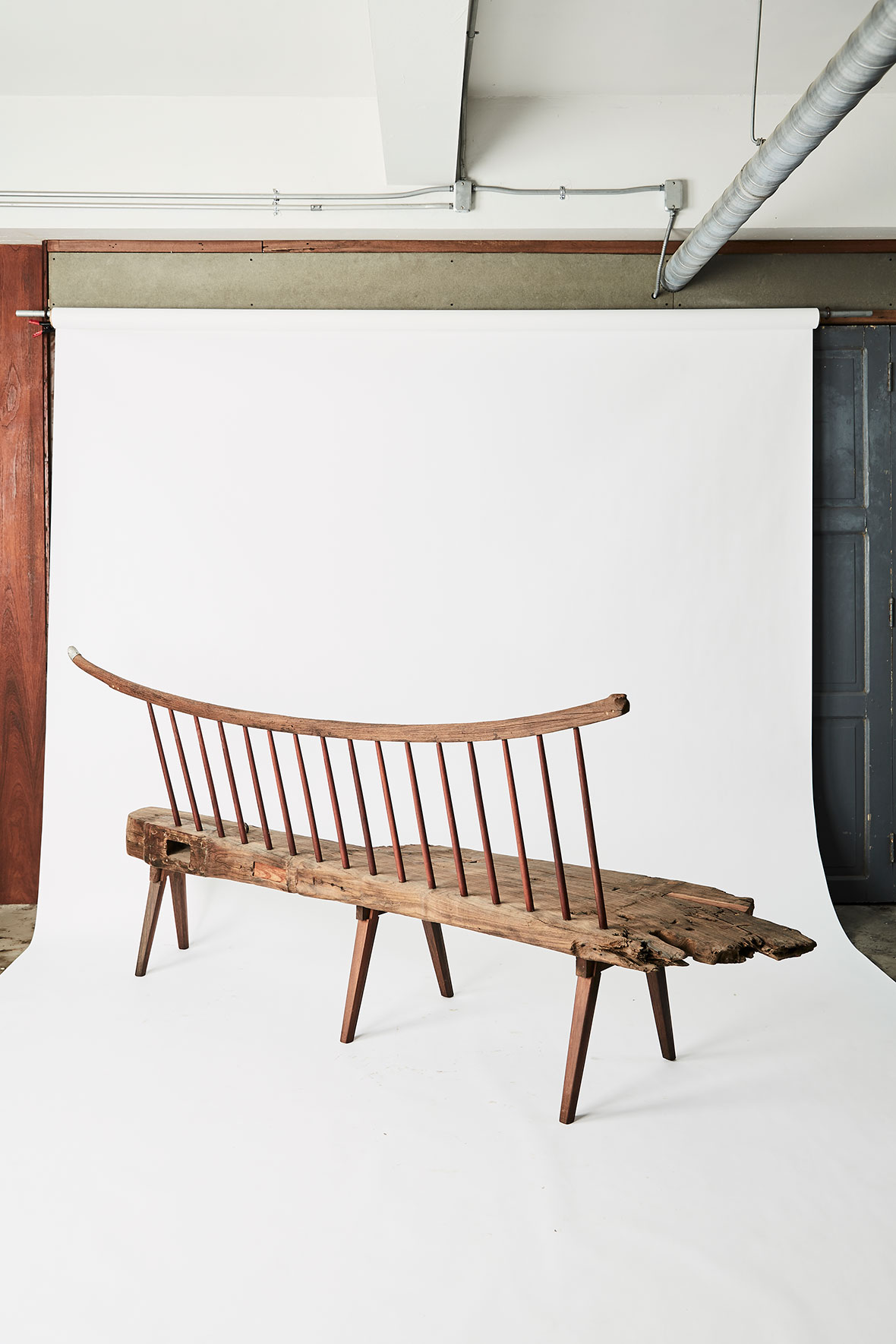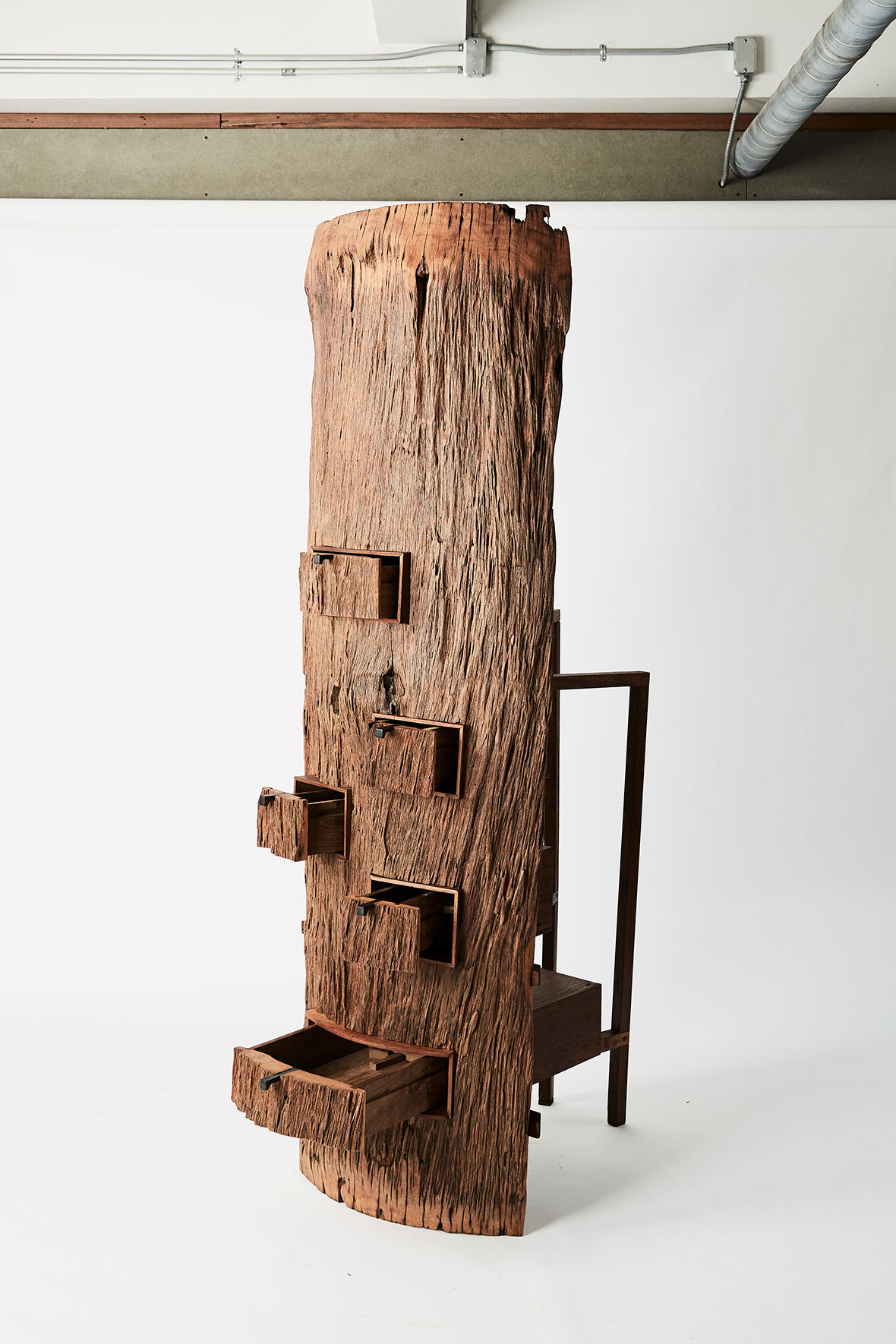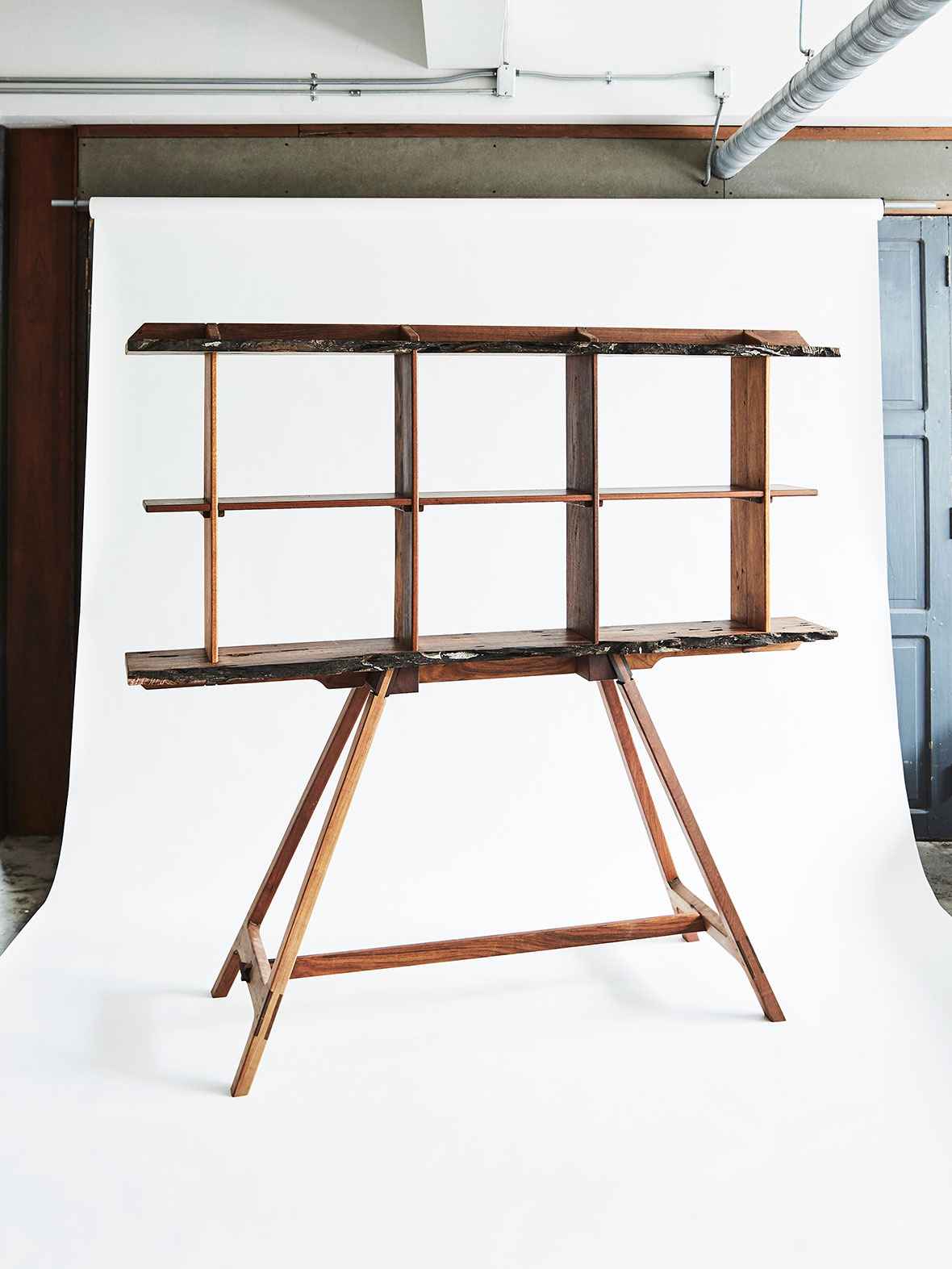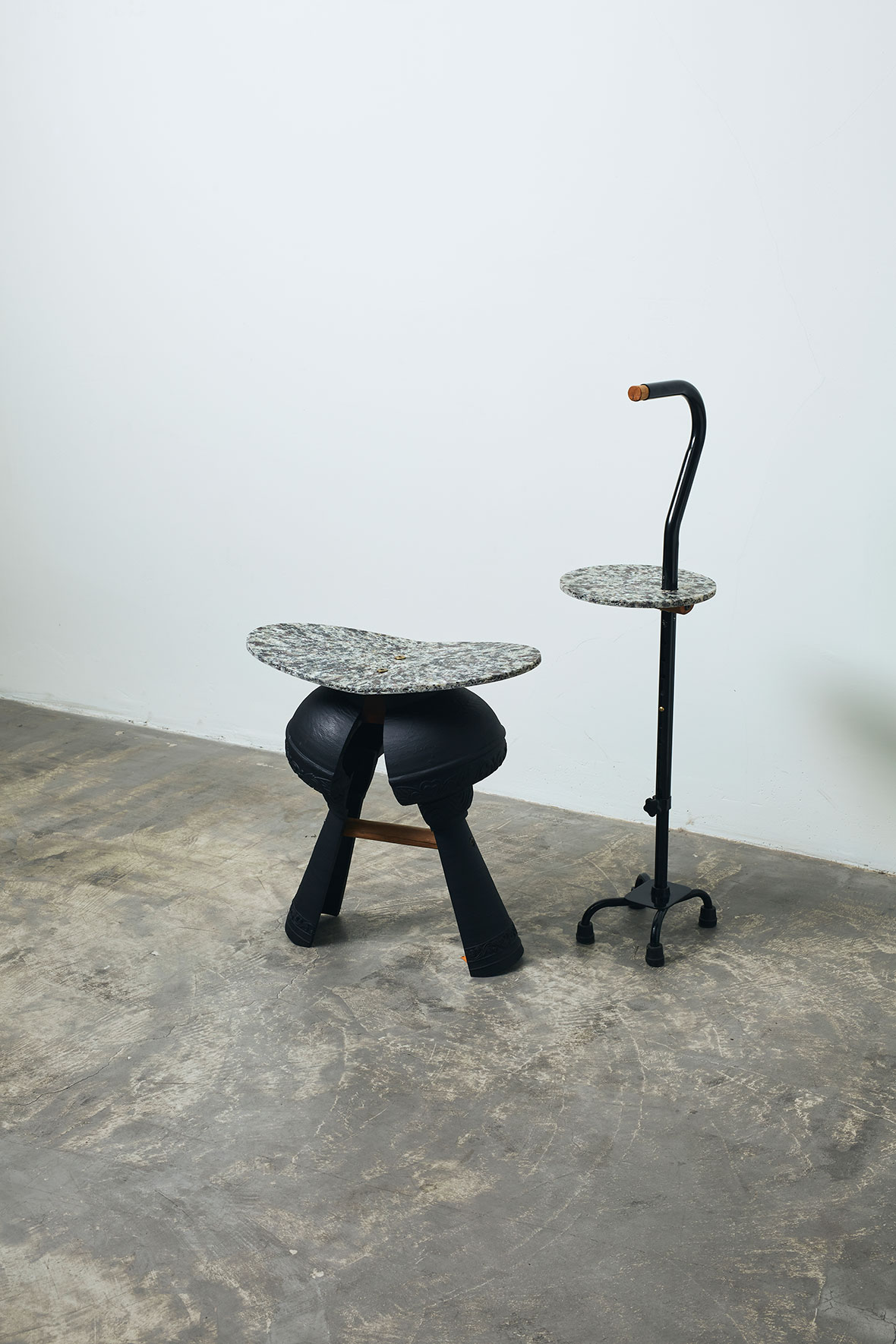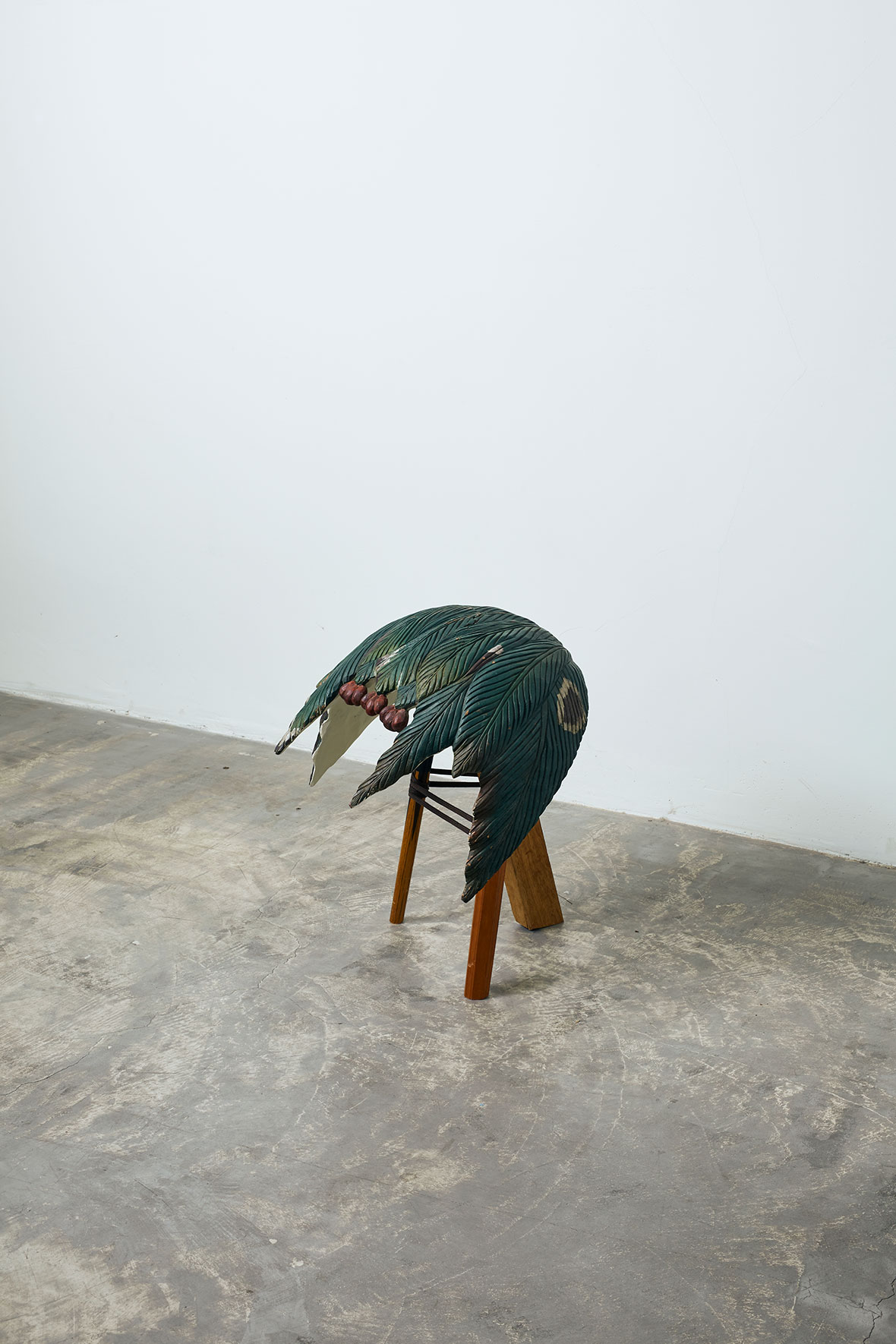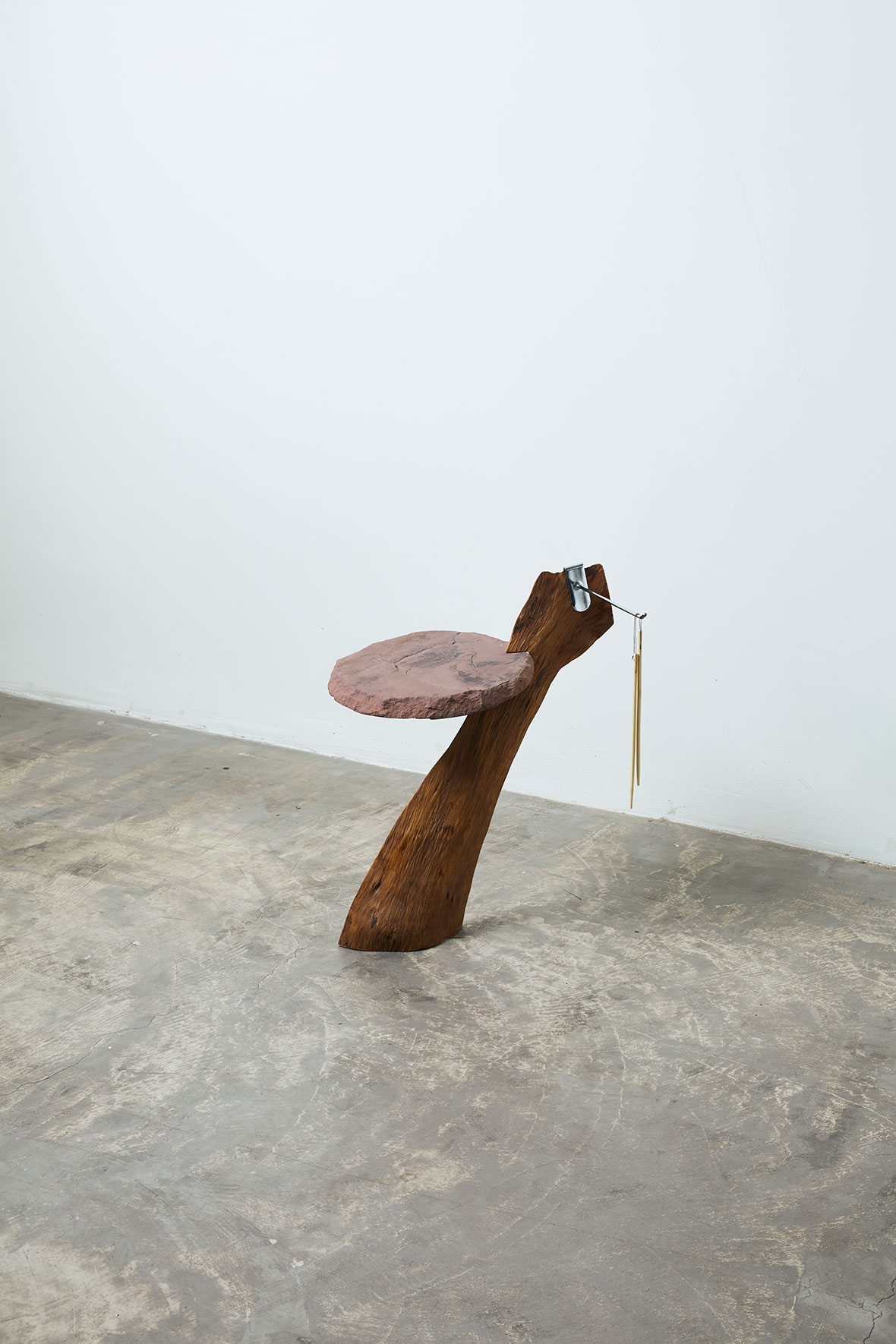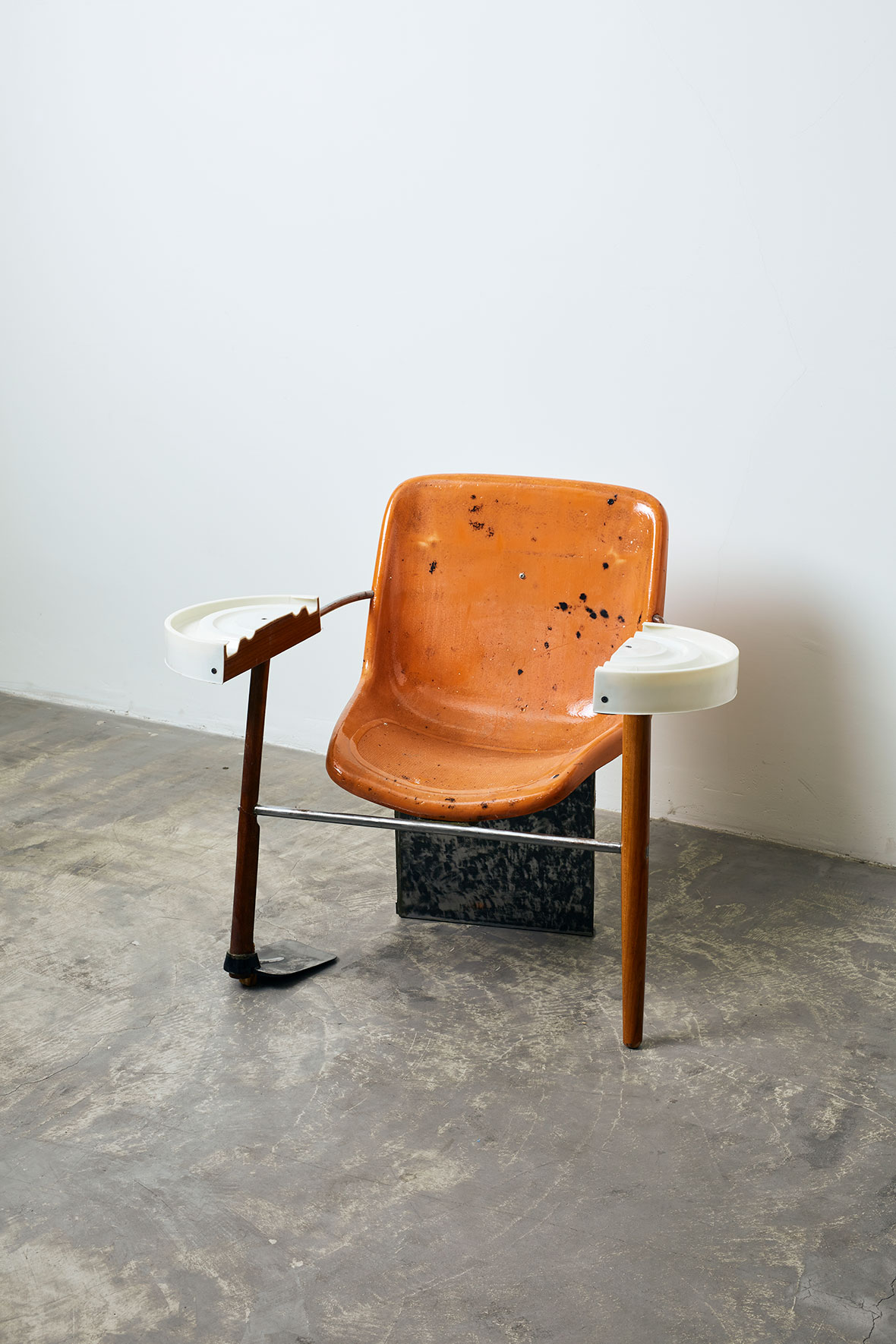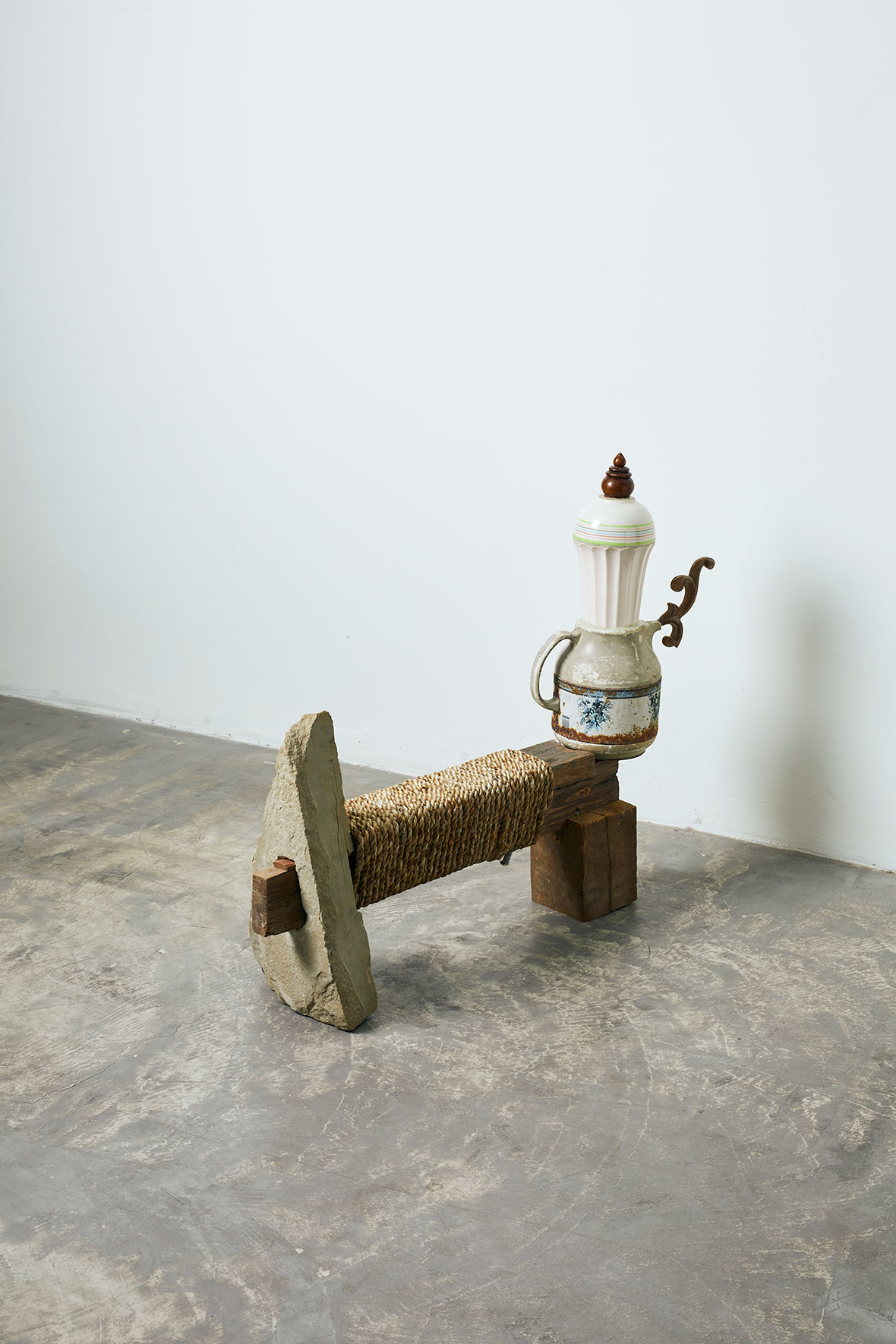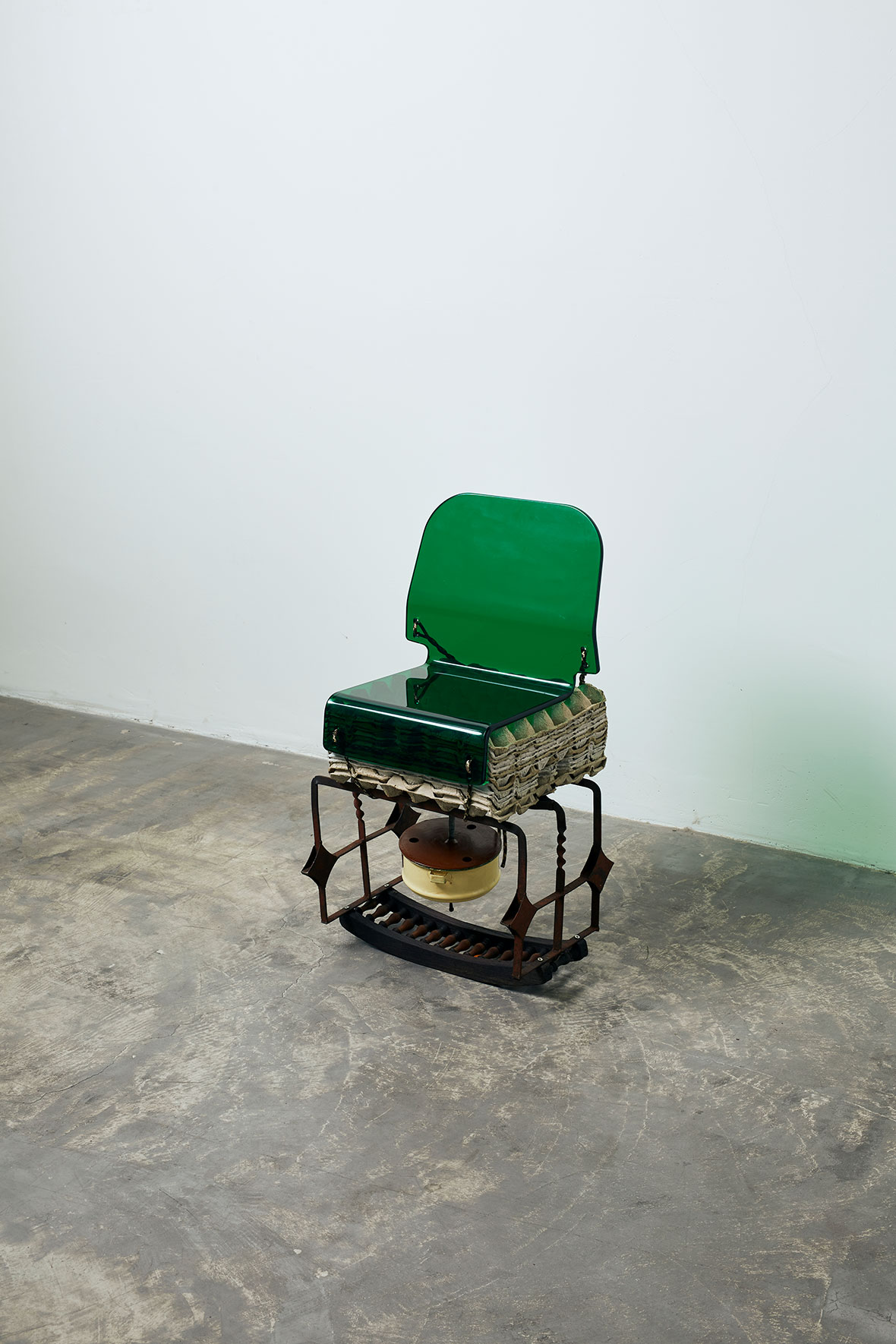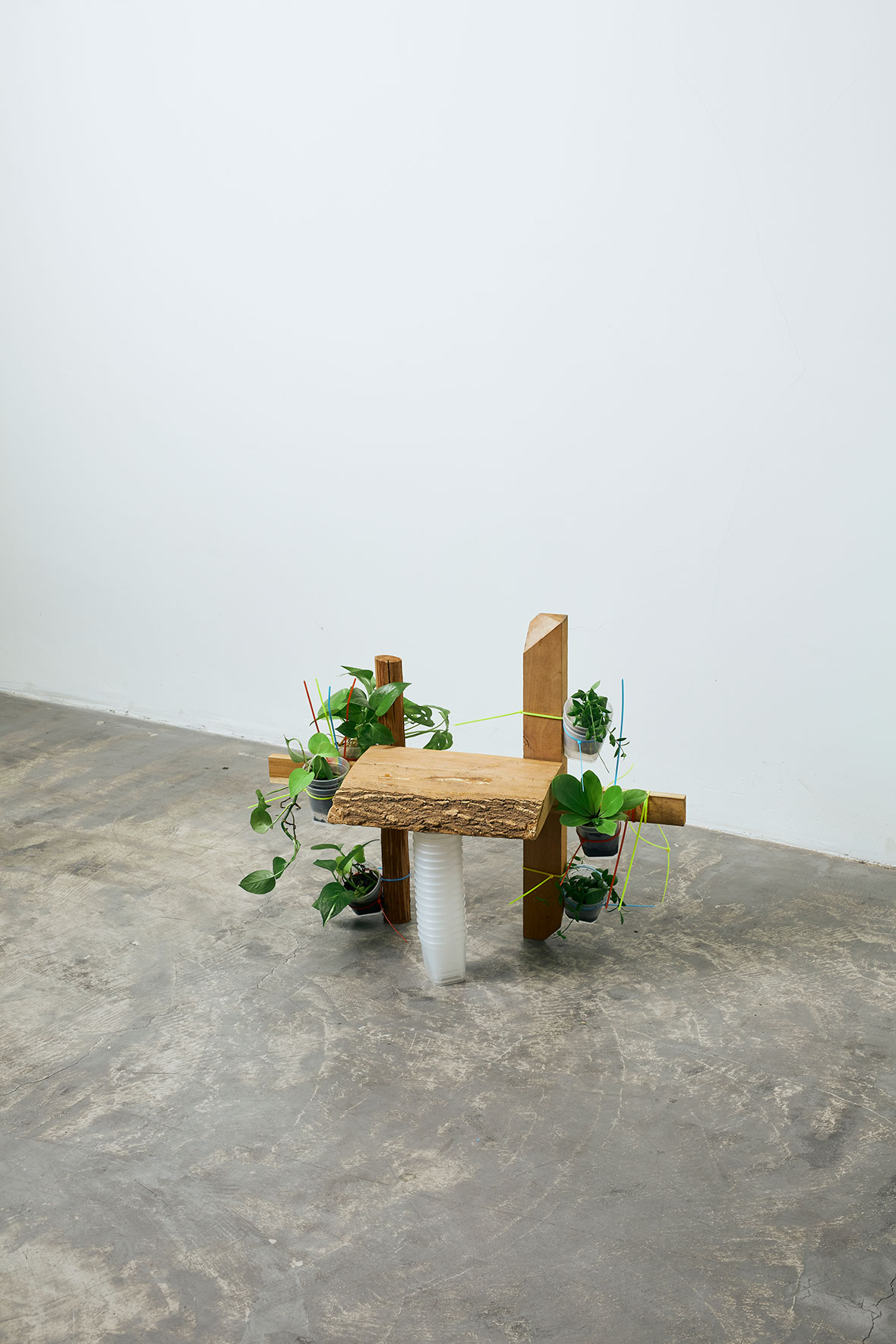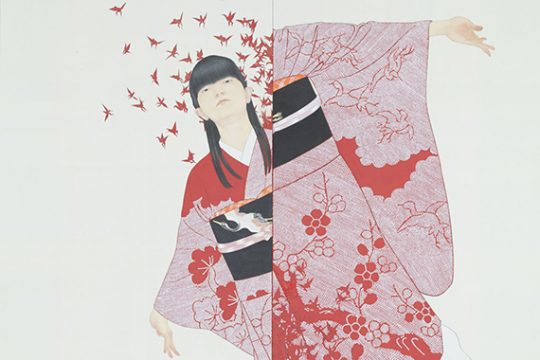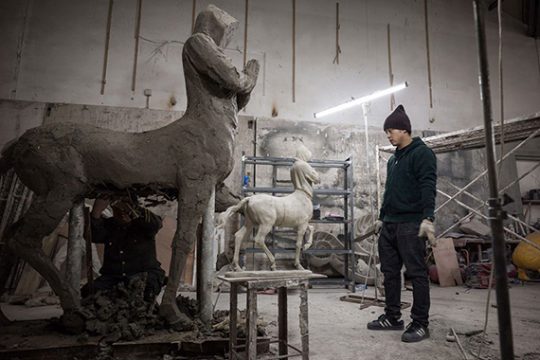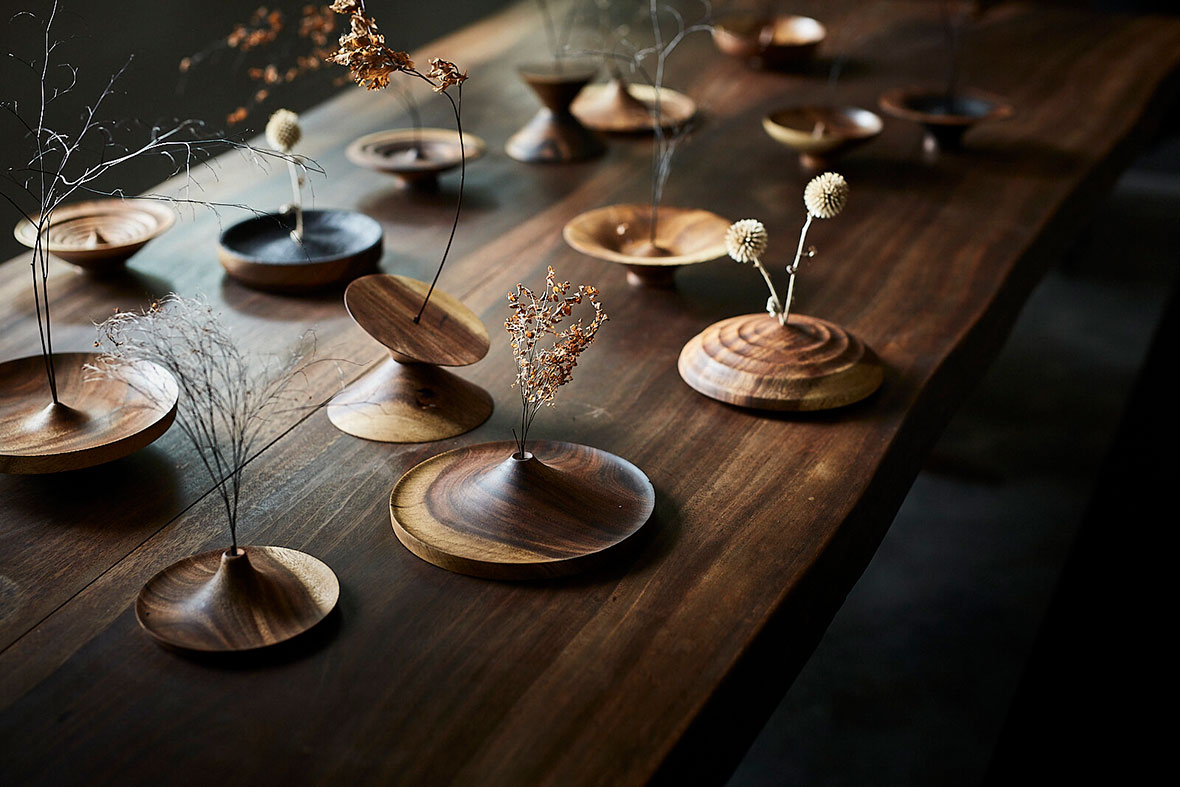
From teak wood furniture to entire houses and temples, Thai woodwork tradition traces back to time immemorial, and it was virtually widespread until recently. “In our grandparents’ time, everyone lived in wooden houses with wooden furniture; cartwheels, tools, utensils—they made everything out of wood,” says Bangkok-based maker Nanu Youttananukorn. He’s the founder of Grains & Grams, a collective of Thai makers drawing from this tradition to create stylish and modern wood pieces that blend art and functionality.
Grains & Grams was officially born in 2017, but some makers were already close-knit and collaborated on occasional projects before that. Youttananukorn was the one to make it official and give it a name and a rough structure. Since then, the group has come together in biannual exhibitions—one always part of Bangkok Design Week, Thailand’s biggest creative event.
从柚木家具到整幢房屋和寺庙,泰国木工传统可追溯到古老的年代,但直到最近,这股热潮才真正蔓延开来。“在我们祖父母那个年代,人人住在摆满木制家具的木屋内:车轮、工具和各种器皿,一切都是木制的,”曼谷匠人 Nanu Youttananukorn 说。他是泰国匠人艺术家团体 Grains & Grams 的创始人,该团体旨在从传统木工中汲取灵感,打造融合艺术与功能性的现代木制品。
Grains & Grams 正式成立于 2017 年,但在此之前,几位匠人艺术家早已建立了往来,偶尔一起合作项目。Nanu 正式成立该团体,由他为团体命名并大致制定了团体的方向。从那时起,团体每年会合作举办两次展览,该展览也是泰国最大型的创意活动——曼谷设计周的一部分。
As Youttananukorn explains, the unspoken, positive peer pressure within the group drives each maker to develop their craft further and find their unique artistic stand. “Everyone has a different style, and they are known for doing one specific thing,” he says. “When this group dynamic happens, we get to know different ideas, and our decisions become clearer. Each of us knows where we should go, which makes everyone else’s work more pronounced.”
Each member of Grains & Grams has a unique and distinct style, but their practices still converge because they all share a common reverence for nature and the material. There’s also something else that binds most of them: at some point in their lives, they felt unhappy with their careers and found in wood a new path forward.
We talked to five of these makers to understand their trajectory, how they relate to the material, and to know what woodworking means to them.
正如 Nanu 所说,团队内部有一种同伴之间正向的压力,驱使每位艺术家进一步提升自己的手艺,并找寻自己独特的艺术风格。他说:“每个人的风格都各不相同,每个人都有自己的擅长之处。团队中的这种动态力量有助我们了解不同的创意,决策也会变得更加清晰。每个人都知道我们的方向,这也使得每个人的作品更具有鲜明特色。”
Grains & Grams 的每位成员风格各异,但又异曲同工,因为他们对自然和材料有着共同的敬畏之心。除此之外,他们中大多数人还有一个共同点:他们都曾在人生某个时刻,不满于自己的事业,然后在木工中找到新的前进动力。
我们与其中五位匠人艺术家聊了聊,以了解他们的故事、他们与材料的关系以及木工对他们的意义。
Nucharin Wangphongsawasd
Drawn to principles of good design, Nucharin Wangphongsawasd pursued her bachelor’s degree in architecture in industrial design. However, her experience working in the industry was nerve-wracking, to say the least. “It drove me a bit insane,” she confesses. “And I felt something was missing, something more that I longed for.”
Eager to find the missing piece, Wangphongsawasd enrolled in the Master of Fine Arts program at the prestigious Rochester Institute of Technology in Rochester, New York, specializing in fine woodworking and furniture design.
After her time in the United States, she carried her appreciation for American wood back to Thailand. Wangphongsawasd still works with ash, poplar cherry, and white oak. “These are the wood species from when I began my training in the US. They comfort me and make me feel at home,” she says. These are also the most suitable species of wood for bending and twisting, a technique she commonly uses to form exquisite curved shapes in her furniture and sculpture pieces.
“My philosophy is simple: I want to keep doing what I do and be consistent and self-disciplined. I’m strict with myself when I need to be self-critical, but I’m also kind, especially when I’m not in the right state of mind,” Wangphongsawasd shares. Her practice carries profoundly personal meanings, feelings, and memories that reflect her life experiences, all of which she wants to share with the audience through her work.
Nucharin Wangphongsawasd
出于对优秀设计原则的兴趣,Nucharin Wangphongsawasd 曾攻读工业建筑设计学士。然而,在这个行业工作的经历令她感觉很郁闷,“这份工作让我难以忍受,”她坦白道,“我总是惘然若失,感觉有其他更向往的东西。”
为了填补失落感,Nucharin 入读了纽约罗切斯特著名的罗切斯特理工学院,攻读美术硕士课程,专业是精细木工和家具设计。
完成美国的学业后,她带着美国木工文化回到了泰国。一直以来,Nucharin 喜欢以白蜡木、杨木、樱桃木和白橡木来创作,“这些是我开始在美国学习时所用的木材品种。使用这些木材能让我感到平静自在,有一种回家的安定感,”她说。另外,这些木材也是最适合弯曲和扭曲的木材品种,这也是她在制作家具和雕塑作品时需要用到的工艺。
“我的理念很简单:我想继续做现在所做的事情,保持一致和自律。当我需要自我批评时,我对自己会很严格;但我有时也会对自己温柔一点,特别是当我心态不太好时,”Nucharin 分享道。她的创作承载着深刻的个人意义、感受和记忆,反映着她的生活经历,而所有这一切正是她希望通过自己的作品与观众所分享的。
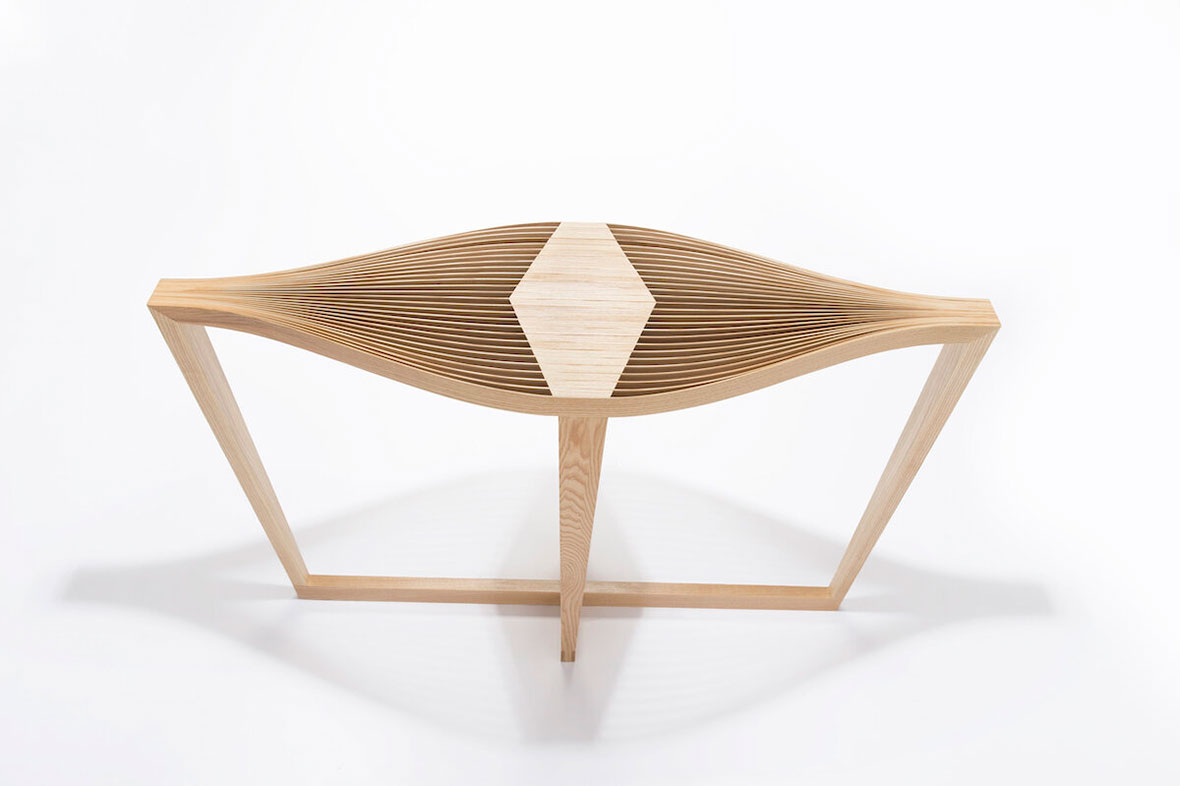
Pichan Sujaritsatit
Holding a degree in photography, Pichan Sujaritsatit worked for a magazine for about five years, taking photos and running its general artistic direction. During his time in the publication, he had the chance to interview and photograph several creatives—many of whom were makers. This was when he became interested in craftsmanship. “I liked the idea of making things with your own hands and turning them into something useful. It’s a good practice of self-reliance,” he says, adding that when he took matters into his own hands, literally speaking, “even fixing a tap was a cool thing.”
Sujaritsatit became a maker in 2014, and he developed his practice by working across several materials other than wood, such as ceramics, terrazzo, and brass casting. “Not everything has to be made of wood. Each material is suitable for something specific. If you have to force it into something, it does not come out naturally,” he says.
Sujaritsatit commonly uses a wood-turning machine to create his pieces. He makes table lamps, plates, trays, and tiny vases, among other objects, always keeping the character and the grain patterns of the wood, which gives each piece a unique personality.
He draws much of his inspiration from traditional Thai woodwork, especially from the minor details he observes in the different techniques from various parts of Thailand. “When I travel to other provinces, I like to notice the wooden houses and the different methods used by local artisans. It’s like reading a history book—the history of good craftsmanship,” he says.
Sujaritsatit feels that, by observing local artisans closely, he can perceive revealing patterns in their work, such as how diligent they are and how much attention they pay to details. “I enjoy watching a village artisan working. Their work often looks simple. Even if it has joinery, it’s not complicated. You could even call it naïve,” he says, and he points out that, compared to Japanese carpentry, for instance, Thai carpentry is not as solemn; much on the contrary, it’s simple, and laid back, just as Thai people are.
Pichan Sujaritsatit
Pichan Sujaritsatit 拥有摄影学位,曾在一家杂志工作了大约五年,负责拍摄照片和艺术指导。在出版行业工作期间,他有机会采访和拍摄了多位创意人,其中包括多位手工匠人,从那时起便对手工艺产生了兴趣。他说:“我喜欢亲手制作物品,让不同材料物有所用。这是一种自力更生的好习惯。”接着,他又表示,自己动手的时候,“即使是修理水龙头也变成一件很酷的事。”
Pichan 在 2014 年如愿成为一名手工匠人,除了使用木材,他还会用到其他几种材料,如陶瓷、水磨石和黄铜铸件。“不是什么都非得用木头来做,每种材料都有其适合的用途。如果强行将它变成某种物件,效果反而不自然,”他说。
Pichan 通常使用木材车削机来打造作品。他所制作的台灯、盘子、托盘和小花瓶等物品会保留木材的特色和纹理图案,因此,每件作品都有各自的风格。
他从传统的泰国木制品中汲取了许多灵感,特别是在泰国各地的不同工艺中,他所观察到的各种小细节。他说:“去其他省份旅行时,我喜欢去观察木屋和当地工匠使用的不同工艺,就像是在阅读一本关于优秀手工艺的历史书。”
Pichan 认为,通过仔细观察当地工匠,他可以从他们的作业过程中发现一些规律,勤奋、和注重细节是匠人必不可少的基本素质。他说:“我喜欢观察乡村工匠作业。他们的工作通常看起来简单。即使涉及细木工作,也并不复杂,甚至可以说作品还很不成熟。”他指出,与日本的木作工艺相比,泰国木工没有那么严谨;相反,它更简单,更随心所欲,正如泰国人的性格一样。
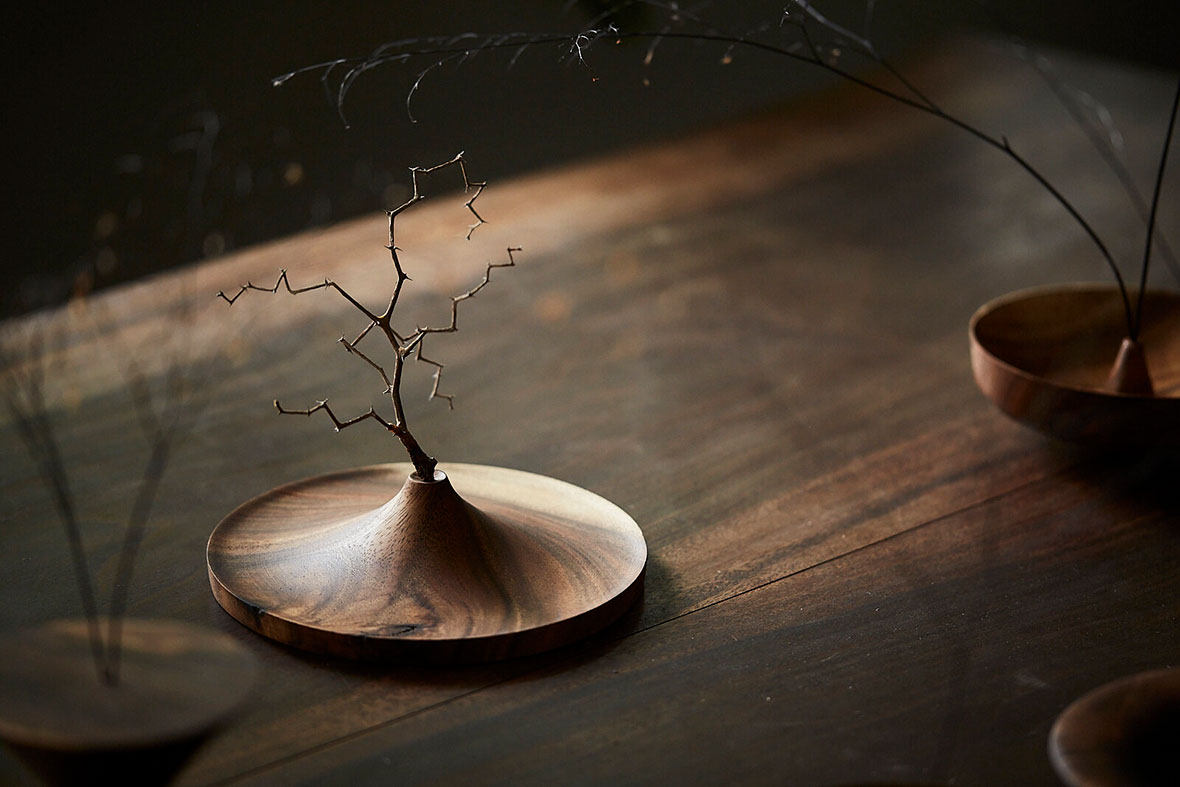
Phakphoom Wittayaworakan
A little over ten years ago, Phakphoom Wittayaworakan left his business as a vet in Bangkok and moved to quieter Isan, Northeastern Thailand. His goal was to start a new life based on the principles of self-sufficiency and sustainability. His interest in woodwork came naturally, a practical need of his alternative lifestyle, but his intimacy with the material grew with time. Today, wood is an essential part of Wittayaworakan’s life. “It’s a religion, food for the soul, and mental therapy,” he says.
Wittayaworakan often makes everyday utensils, such as plates and trays, cutlery, and cutting boards. He shapes them with hand carving tools, giving them an organic, folkish aspect. Another prominent characteristic of his work is that he often finishes his pieces with a burning technique, giving them unique textures, black as coal.
He sources most of his wood from his surroundings in Isan. The region has a long dry season and is known for its deciduous trees with robust hardwood, but there’s something beyond the material’s intrinsic qualities that also attracts him. “Working with local wood allows me to understand how local people relate to wood in another dimension. I often source wood from people who live out of lumber to burn charcoal; sometimes, I get wood from villagers that had to cut down trees to grow their farming areas,” Wittayaworakan says.
What fascinates him the most about his practice is observing the long-standing connection between trees, wood, and people. “Wood is a material so close to us that we feel familiar and connected to it. We love to touch it and use it intimately in many aspects of life,” he says. “I’m happy that I can understand the true nature of wood. Deep down, it also helps me to understand my own nature.”
Phakphoom Wittayaworakan
十多年前,Phakphoom Wittayaworakan 辞掉在曼谷的兽医工作,搬到了泰国东北部的伊桑。他的目标是在这里开始一种自给自足的低碳新生活。他之所以对木工产生兴趣也很顺理成章,毕竟对于他这种另类的生活方式,这是很实际的需求;但随着时间推移,他与木材之间的关系也日益亲密。如今,木材已成为 Phakphoom 生活中必不可少的一部分。“它是一种信仰,是灵魂的食粮,也有治愈心灵的作用,”他说。
Phakphoom 大部分作品都是日常用具,例如盘子和托盘、餐具和砧板。他的作品通常纯手工打造,赋予作品一种有机、质朴的风格。此外,他经常采用烤烧工艺来处理成品,赋予作品独特的质感,让部分外表黑若焦炭。
他所用的大部分木材都来自他在伊桑住所的周边地区。当地有漫长的旱季,以落叶树及其坚固硬木而闻名,但这种材料还有其他吸引他的地方。“使用当地木材使我能够从另一维度了解当地人与木材的关系。我采购木材时,发现很多人靠燃烧木材以制成木炭为生,还有的村民不得不砍伐树木来开垦农地,”Phakphoom 说。
这种手工艺最让他着迷的是观察树木、木材和人之间长久的联系。“木材是一种离我们生活很近的材料,这种关系很亲密。我们喜欢触摸木材,在生活很多方面都会用到木材,”他说,“我很开心能够理解木材的真正本质。在内心深处,木材也帮助我了解自己。”
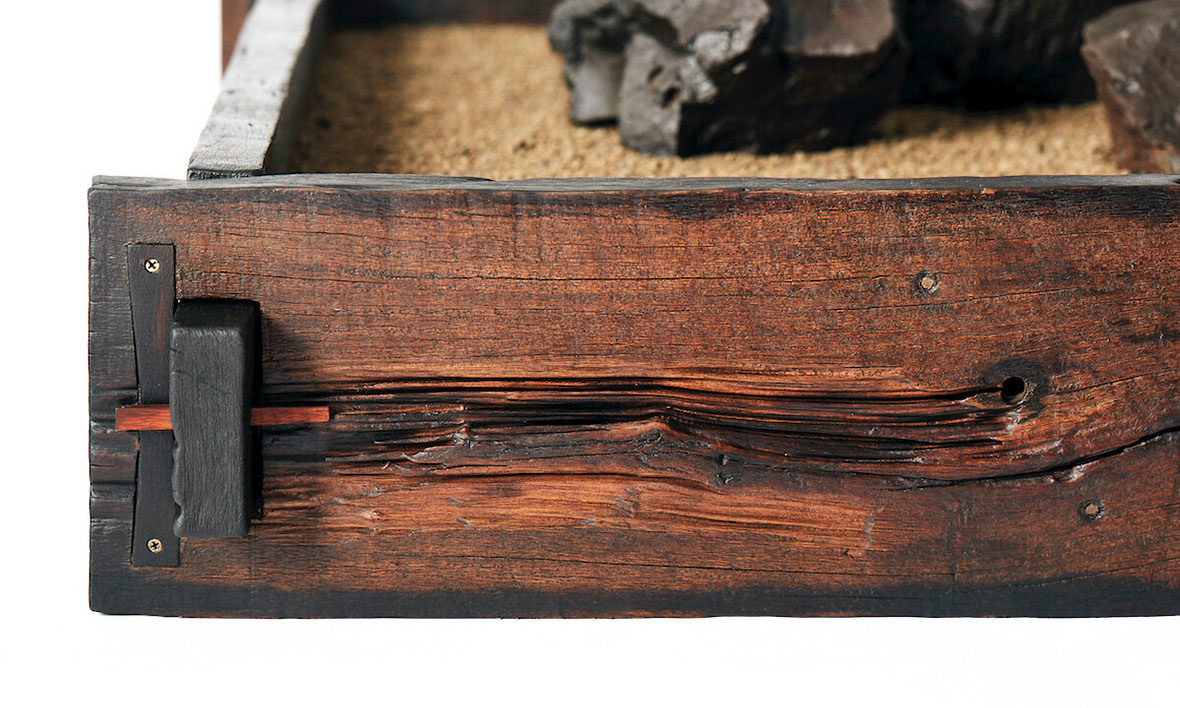
Charnon Nakornsang
Trained as a graphic designer, Charnon Nakornsang worked in corporate jobs for ten years before realizing a life behind the computer screen wasn’t for him. Interestingly, Baz Luhrmann’s The Great Gatsby was what kindled his interest in woodwork. The design of Nick Carraway’s cottage in the film fascinated Nakornsang because of the abundance of beautiful wood details it displayed, all simple yet sophisticated.
With some research, Nakornsang discovered the works of George Nakashima and James Krenov, both acclaimed woodworkers who had an influence over him. Nakornsang was fascinated by them, from the tools they used to their joinery methods, but mainly how they cherished the natural expression of the material and often kept it as a prominent visual asset in the piece.
Nakornsang’s practice is primarily functional. His pieces are mainly born from his own daily needs, and we can see most of them neatly displayed in his living room, which sometimes doubles as a showroom. “I always start from the function, thinking of how it will serve the body, then of scale and structure, and then about the joinery, shape, and form,” he says. “It’s a simple step-by-step.”
He avoids nails as much as he can. Instead, he prefers to use tight-fit joinery reinforced with glue, which is like the resin of a tree to him. It’s his way of replicating the natural structure of the tree. Nakornsang also keeps the imperfections, lines, grains, and wood texture in everything he creates, balancing them out for an aesthetically pleasing result.
“If you cut the tree, you can see the annual rings. They are seasonal; they grow and stop during winter or grow differently according to light conditions or the drought it experiences. They also have specific colors and pigments. All this together expresses the life of a tree,” Nakornsang says.
Charnon Nakornsang
Charnon Nakornsang 有过平面设计专业背景,曾在一家平面公司工作了十年,直到他意识到,坐在电脑屏幕前的生活并不适合自己。有趣的是,激发他对木工兴趣的是巴兹·鲁赫曼(Baz Luhrmann)导演的电影《了不起的盖茨比》(The Great Gatsby)。影片中,尼克的木屋有着大量漂亮的木工细节,简单而不失精致,这些画面深深吸引了 Charnon。
一番研究之后,Charnon 发现了 George Nakashima 和 James Krenov 的作品,这两位都是对他影响颇深的著名木匠师。Charnon 对二人极为崇拜,从他们使用的工具到他们的细木工工艺,以及他们如何保留材料的自然表达,并将其变成作品中突出的视觉元素。
Charnon 的创作以功能导向,其作品主要源于自己的日常需求。“我总是从功能开始,思考它将如何为人服务,然后才是大小和结构,最后是细木工、形状和形式,”他说,“这是一个循序渐进的思考过程。”
他尽可能避免使用钉子,更喜欢木材之间斗榫合缝的连接,再用胶水加固。对他来说,胶水如同树脂。Charnon 还喜欢在作品中保留材料的瑕疵、线条、纹理和木材质感,并通过平衡处理,呈现出令人身心愉悦的美学效果。
“砍树的时候,你可以看到树的年轮。年轮有季节性,在冬季会停止生长,或根据光照条件或干旱情况而以不同的方式生长,而且还具有特定的颜色。所有这些都体现了大树的生命,”Charnon说。
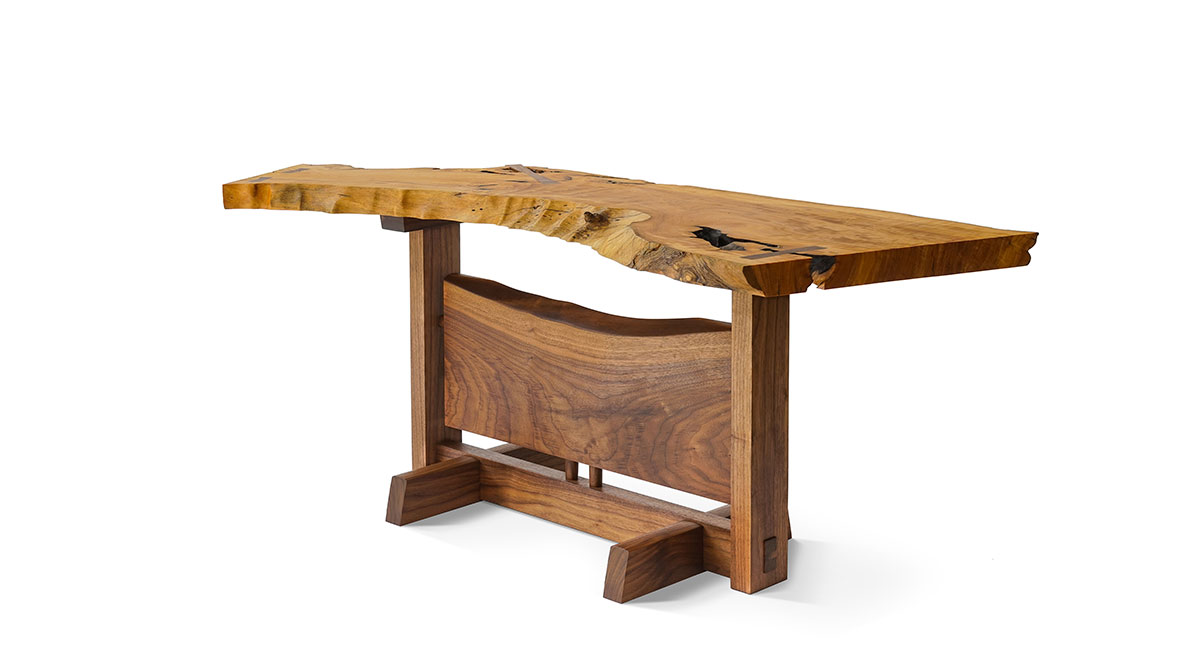
Nanu Youttananukorn
Before founding Grains & Grams, Youttananukorn also worked in an office as a graphic designer. However, at age 29, anguished by the routine, he chose to take a different path in his life and moved to The Netherlands for a master’s in social design at the Design Academy of Eindhoven, where he specialized in construction methods and materials.
Back in Bangkok, he experimented with several materials, but wood was the one that caught him. Youttananukorn learned most of what he knows today by spending time in the studios of more senior artisans. “It was like being in an anatomy class. The more I saw wood, the more I liked it,” he remembers.
Like Wittayaworakan, Youttananukorn is drawn to local Thai wood and the unprocessed way it’s presented and sold in wood markets. “In Europe, you get a lot of processed wood, but the natural form is often kept in Thailand. We can see what it looks like when it gets old and the grains it exposes.”
Youttananukorn mainly works with raw, freshly cut slabs or old reclaimed pieces of wood from Thai houses, boats, and other objects. The essence of his work lies in the juxtaposition of the natural expression of wood and his minimal intervention over it. “I don’t want to overcome the natural voice of the material with my own,” he says.
Youttananukorn believes that each piece of wood carries history and that his reclaimed parts connect him to other people—that’s what he loves the most about his practice. The simple act of removing old nails and screws from an old piece of wood sets his mind on imaginary journeys. “I think about the person who banged those nails. It’s almost as if you are getting into another person’s life,” he says.
Nanu Youttananukorn
在创立 Grains & Grams 之前,Nanu 曾在一家公司里担任平面设计师。然而在 29 岁那年,千篇一律的工作令他深感痛苦,最终选择走上另一条不同的人生道路,并移居荷兰,进入埃因霍温设计学院攻读社会设计硕士学位,专门研究建筑方法和材料。
回到曼谷后,他尝试过用多种材料进行创作,最终选定了木材。Nanu 所掌握的大部分知识都是他在资深工匠工作室中学到的。“感觉就像在上解剖学课一样。对于木材,我看得越多,就越喜欢,”他回忆道。
和 Phakphoom 一样,Nanu 很喜欢泰国当地木材及其在木材市场上未经加工的原始感。“欧洲大部分都是加工木材,但泰国这边更喜欢保留木材的原貌。我们可以看到木材老化的样子以及表面的纹理。”
Nanu主要使用未加工、新鲜砍伐的板材,或是从泰国房屋、船只和其他物件中回收的旧木材。其作品精髓在于糅合木材的自然表达与对木材的加工。他说:“我不想让自己的加工盖过材料本身的自然本质。”
Nanu 认为,每一块木材都承载一段历史,所回收的木材能将作品和他人联系起来,这也是他在创作中最喜欢的部分。从旧木头上拆掉旧钉子和螺丝这些简单的举动,也能让他在脑海里开始一段想象的旅程,“我会想到了当初敲钉子的人,感觉自己仿佛进入了另一个人的生活中,”他说。
In his unofficial position as a community leader of Grains & Grams, Youttananukorn likes to distinguish their shows from standard furniture showrooms by coming up with themes that invite personal reflection.For their latest show, part of Bangkok Design Week 2022, he drew inspiration from the notion that in design, as in life, you’re often subject to external factors, things you have no control over. That’s how he arrived at the concept of 12 Camels.
“A camel is a horse designed by a committee,” Youttananukorn says, quoting Alec Issigonis, the British designer of the Mini Cooper. According to Issigonis, contrasting with the anatomically perfect horse, the camel, a weirdly shaped animal with humps on its back, curved neck, and disproportionately long legs, is equivalent to the result of too many conflicting opinions and inexperienced inputs in any design process.
12 Camels didn’t only challenge the members’ woodworking skills but their ingenuity as makers on a broader scope. Their task was to create a stool—possibly the most elementary piece of furniture there is—using only reclaimed objects randomly distributed amongst them.
The 12 makers had to pick up the objects themselves. Most of them chose strange things like shovels, plastic bones, empty egg cartons, and popsicle sticks, among many other seemingly useless objects. They had no limitations of material or shape. The only requirement was to select four pieces: three legs and a seat.
作为团队里非正式领袖,Nanu 喜欢为团队的项目和 Grains & Grams 的展览加入一些充满挑战的元素,“否则,你的生活只能原地踏步,”他笑着说,“创作上的挑战让我们的展览区别于普通的家具展览,而且艺术家自己也可以摆脱客户委托作品的条条框框。”
团体最新的展览参加了 2022 年曼谷设计周,这场展览的灵感源于一个概念,即设计和生活一样,往往要受到外部因素的影响,一些你无法控制的事情。“12 Camels”(十二匹骆驼)系列的概念也由此诞生。
“骆驼是设计师眼中的马,”Nanu 引述 Mini Cooper 的英国设计师 Alec Issigonis 的话说道。Alec 认为,与解剖学意义上完美的马相比,骆驼是一种形状独特的动物——背部凸起的驼峰、弯曲的脖子和不成比例的长腿,就像是设计过程中由于有太多相互矛盾的意见和缺乏经验导致的结果。
“12 Camels” 给成员带来的挑战不仅是其木作工艺,也挑战了他们作为匠人的创作独创性。他们的任务是制作一张凳子,虽然是很基本的家具,但他们只能使用随机散落在身边的回收物品作为创作素材。
Once they selected their objects, the makers handed them to Youttananukorn, who redistributed them, with each maker receiving four new parts. He used a computer allocation software to guarantee that the project relied on fairness or, better yet, the unfairness of life. Some makers were lucky, receiving parts with rather obvious functionalities, but others had it worse. “What can you make with plastic cups and bone parts?” Youttananukorn laughs.
Again, positive pressure played a role, but this time, the pressure also came from outside the group, from the many people who crossed Bangkok Design Week’s exhibition halls, Thailand’s biggest creative event. “It’s their name on the line, after all. I can imagine myself getting some of these tough pieces. I would throw them on the wall, kick them or something. But life is not fair. Things are set up for you, and you can’t choose,” Youttananukorn says.
The makers had roughly a month to create their stools out of the materials they received. They could bring in additional parts to compose them if needed, and they could do whatever they wanted, as long as the stool would stand by itself in the end. To Youttananukorn, the algorithm allocated the rim of a bicycle wheel, two wooden sticks, and a metal tray. “In the beginning, I thought I wasn’t so lucky to get the wheel. But then I threw it somewhere, and it started to wobble. Then I thought that’s it: I’m making a rocking chair,” he says.
Youttananukorn split one stick in half and, together with the other one, made the three legs of the stool, connecting them to the wheel as a base. The metal tray became the framework for the seat. Youttananukorn only had to add a cushion to it, which he got from a motorbike shop. His stool is strong enough to sit and rock a little.
A cow bone he picked up from a butcher shop was among his contributions to the cluster of disconnected items. It ended up with Sujaritsatit, who also cut the bone in two and used them as feet for his stool. To them, he welded a fire extinguisher stand, another of his allocated items, making the primary structure for his stool. He made his seat of thin wooden pieces using the Japanese Kumiko technique and giving it a highly decorative pattern.
每位艺术家选好要用的物品后,就把它们交给 Nanu,再由 Nanu 重新分配,这样每个艺术家最后都会收到四个新的零件。Nanu 使用电脑分配软件来保证该项目的“公平”。有的艺术家比较幸运,收到了有着明显功能性的零件,而有的艺术家则没那么幸运,“你能用塑料杯和骨头做什么?”Nanu 笑着说道。
正向压力再次发挥作用,不过这一次,他们的压力也来自团队之外,来自众多前往曼谷设计周展厅的人,这可是泰国当地最大型的创意盛事。“毕竟,他们的名字会印在上面。我可以想象,假如自己分配到那些比较有挑战性的物品,我大概会气得把它们扔到墙上,用力踢几下。但生活本来就是不公平的。很多事情都是生活早已为你准备好的,你别无选择,”Nanu 说。
每位艺术家有大约一个月的时间用收到的物品来制作凳子。如果有需要,他们可以加入其他物品,并且他们可以自由发挥,只要最后凳子能独立摆放着就行。Nanu 被分配到一个自行车轮圈、两根木棍和一个金属托盘。“一开始,我觉得拿到轮圈是一件挺倒霉的事。直到有一次在移走轮圈时,看到它在摇晃,我突然灵光一闪:就做一把摇椅吧,”他说。
Nanu 将三根棍子组成三脚凳,轮圈被用来制作凳子底座,金属托盘用作凳子框架。这样制成的凳子很坚固,无论怎么摇晃也不会垮塌。
这些毫不相干的制作材料,还包括一块他从肉店捡到的牛骨头。这块牛骨头被分配给 Pichan。他也把骨头切成两半,用作凳脚。然后焊接上他另外分配到的一个灭火器支架,制成凳子的主要结构。他运用日本的“组子”(Kumiko) 工艺,并融入了装饰性图案。
There were many other ingenious creations, including a stool made of a wood slab and a stone disk, balanced out with hanging chopsticks by jeweler maker Rudee Tancharoen, and even a stool with an additional side table by designer duo Jutamas Buranajade and Piti Amraranga. Interestingly, they used only their allocated objects to make their two pieces; an old copper vase, which they split in half, an acrylic board, which they bent, a cane, and a wooden stick.
Together, the 12 stools compose a creative and humorous display of modern Thai craftsmanship. They remind of Michael Wolf’s Bastard Chairs and Martino Gamper’s 100 chairs and evoke the inventive makeshift designs we often see in the streets everywhere in Thailand—particularly when it comes to informal sitting arrangements, chairs, and stools. 12 Camels has recently traveled to Chiang Mai to showcase the original stools at Kalm Village. In early May, the show’s name changed to 24 Camels since it incorporated the stools of twelve new makers—all of whom have equally racked their brains with their allocated parts.
其他作品也充满巧妙创意。珠宝工匠 Rudee Tancharoen 用木板和石盘制成凳子,最后加上悬挂的筷子作为平衡;设计师二人组 Jutamas Buranajade 和 Piti Amraranga 制作的凳子还带有边桌,他们的作品只使用了分配到的物品,包括一个一分为二的老旧铜制花瓶、一块弯曲的亚克力板、一根手杖和一根木棍,成品十分有趣。
这 12 张凳子组成了一场充满创意与幽默的当代泰式工艺展览,令人想起了 Michael Wolf 的《Bastard Chair》(交椅)和 Martino Gamper 的《100 chairs》(100 把椅子),以及泰国街道上经常看到的那些创意十足、且简陋的“临时座位”。最近,“12 Camels” 将前往清迈的 Kalm Village 展示这些新颖独特的作品。从五月开始,将有另外 12 位匠人艺术家的作品加入该展览。而现在,这 12 位艺术家正绞尽脑汁,用被分配到的物品打造独一无二的作品。
Like our stories? Follow us on Facebook and Instagram.
Instagram:
@grainsandgrams
@nucharin_w
@sujaritsatit
@meanwhile_woodwork
@nakornsang.studio
@nanu_youtti
Contributors: Tomas Pinheiro, Lucas Tinoco
Chinese Translation: Olivia Li
Instagram:
@grainsandgrams
@nucharin_w
@sujaritsatit
@meanwhile_woodwork
@nakornsang.studio
@nanu_youtti
供稿人: Tomas Pinheiro, Lucas Tinoco
英译中: Olivia Li


